翻译技巧1 diction
- 格式:ppt
- 大小:1.58 MB
- 文档页数:33
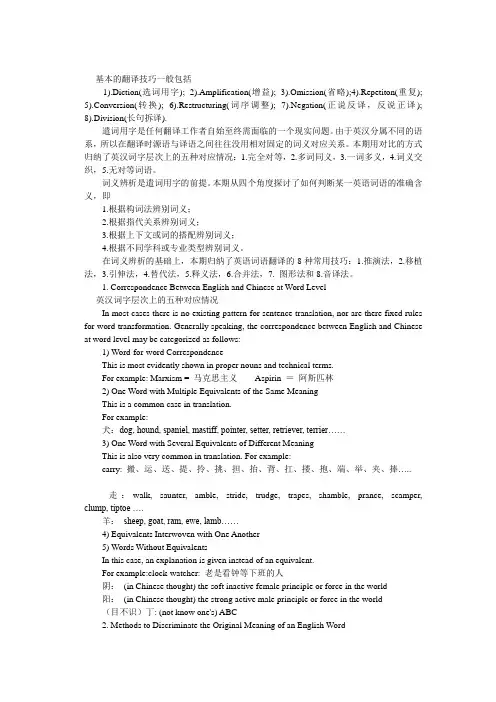
基本的翻译技巧一般包括1).Diction(选词用字); 2).Amplification(增益); 3).Omission(省略);4).Repetiton(重复);5).Conversion(转换); 6).Restructuring(词序调整); 7).Negation(正说反译,反说正译);8).Division(长句拆译).遣词用字是任何翻译工作者自始至终需面临的一个现实问题。
由于英汉分属不同的语系,所以在翻译时源语与译语之间往往没用相对固定的词义对应关系。
本期用对比的方式归纳了英汉词字层次上的五种对应情况:1.完全对等,2.多词同义,3.一词多义,4.词义交织,5.无对等词语。
词义辨析是遣词用字的前提。
本期从四个角度探讨了如何判断某一英语词语的准确含义,即1.根据构词法辨别词义;2.根据指代关系辨别词义;3.根据上下文或词的搭配辨别词义;4.根据不同学科或专业类型辨别词义。
在词义辨析的基础上,本期归纳了英语词语翻译的8种常用技巧:1.推演法,2.移植法,3.引伸法,4.替代法,5.释义法,6.合并法,7. 图形法和8.音译法。
1. Correspondence Between English and Chinese at Word Level----英汉词字层次上的五种对应情况In most cases there is no existing pattern for sentence translation, nor are there fixed rules for word transformation. Generally speaking, the correspondence between English and Chinese at word level may be categorized as follows:1) Word-for-word CorrespondenceThis is most evidently shown in proper nouns and technical terms.For example: Marxism = 马克思主义Aspirin =阿斯匹林2) One Word with Multiple Equivalents of the Same MeaningThis is a common case in translation.For example:犬:dog, hound, spaniel, mastiff, pointer, setter, retriever, terrier……3) One Word with Several Equivalents of Different MeaningThis is also very common in translation. For example:carry: 搬、运、送、提、拎、挑、担、抬、背、扛、搂、抱、端、举、夹、捧…..走:walk, saunter, amble, stride, trudge, trapes, shamble, prance, scamper, clump, tiptoe ….羊:sheep, goat, ram, ewe, lamb……4) Equivalents Interwoven with One Another5) Words Without EquivalentsIn this case, an explanation is given instead of an equivalent.For example:clock-watcher: 老是看钟等下班的人阴:(in Chinese thought) the soft inactive female principle or force in the world阳:(in Chinese thought) the strong active male principle or force in the world(目不识)丁: (not know one's) ABC2. Methods to Discriminate the Original Meaning of an English Word-----词义辨析Since English words are prone to various meanings, it is of vital importance for a translator to discern the right meaning of a given word. And the following are the major methods of discriminating word meaning suggested by some linguists.1) Judging from the Word FormationIn order to discriminate the original meaning of an English word, it is necessary for us to have a knowledge of English lexicology, and specifically, a knowledge of word formation, such as compounding, derivation, affixation, blending, acronym, clipping, etc. A good command of them will help to shed light on the correct meaning of some difficult words.For example, the word ""parabiospheric"", which consists of para-(outside) +bio-(biologic) +spheric (having the form of a sphere). After a brief analysis, we may safely put it into ""外生物层的"". Another more complicated instance, pneumonoultramicroscopicsilicovolcanoconiosis. This extremely long word seems appallingly complicated. However, an anatomic study of its composition enables us to get a clear understanding of its meaning: pneumono- (of lung) +ultra- (beyond) + micro (very small) + scopic- (of viewing or observing) + silico- (of silicon)+ volcano + coni- ( koni, of dust) + osis (forming the name of a disease). Even if we are not sure of the equivalent of this medical term, we may roughly get the right meaning of the long word: a kind of lung disease caused by extremely small silicon particles. And a look into some dictionary leads us to the definite answer: 硅酸盐沉着病,肺尘病(一种矿工易染的病)。

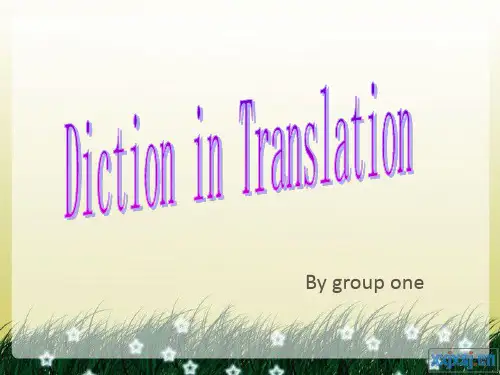
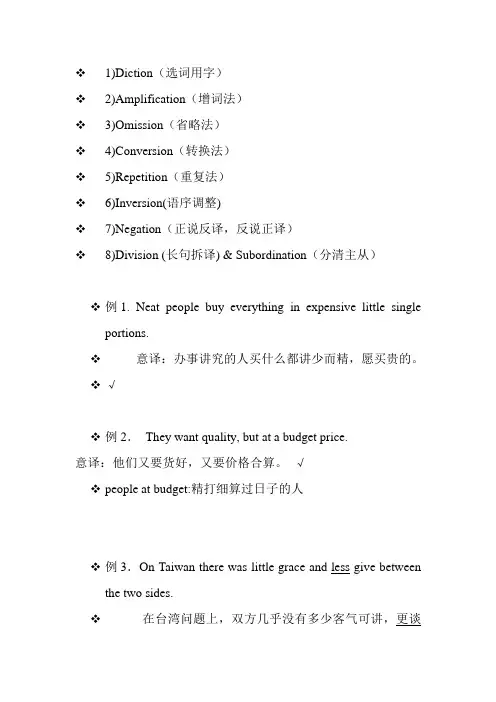
1)Diction(选词用字)2)Amplification(增词法)3)Omission(省略法)4)Conversion(转换法)5)Repetition(重复法)6)Inversion(语序调整)7)Negation(正说反译,反说正译)8)Division (长句拆译) & Subordination(分清主从)例1. Neat people buy everything in expensive little single portions.意译:办事讲究的人买什么都讲少而精,愿买贵的。
√例2.They want quality, but at a budget price.意译:他们又要货好,又要价格合算。
√people at budget:精打细算过日子的人例3.On Taiwan there was little grace and less give between the two sides.在台湾问题上,双方几乎没有多少客气可讲,更谈不上让步了。
例4. Whichever way you choose to visit Zhengzhou , you will reach here quickly and enjoy a comfortable stay, because Zhengzhou has a wide range of accommodation to suit all budgets and tastes…试译:无论乘坐何种交通工具都能迅速抵达郑州,下榻此处会让你倍感舒适,这里的住宿条件能充分满足各种档次和品味的要求……。
例4.New HSR and Maglev would have all-new, state-of-the-art train control system. The Accelerail options were estimate with train control systems providing speed and authority enforcement.译文:新型高速列车或磁浮列车须装置全新的、造形精美的列车操纵系统,可供选用的列车操纵系统必须能提供速度和(威力)强大的加速力。
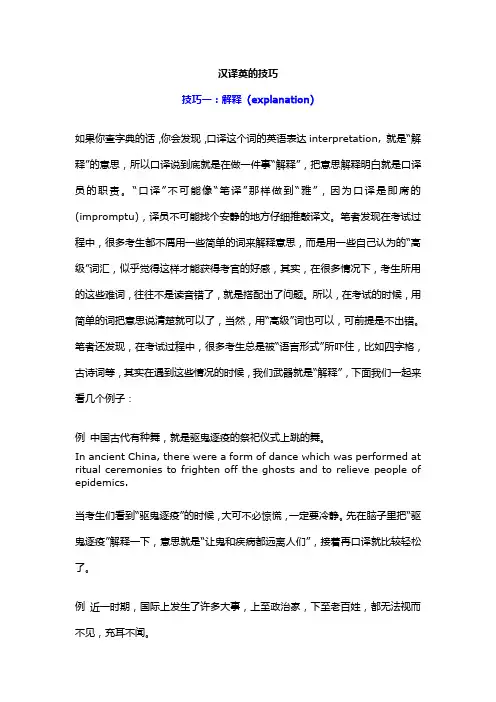
汉译英的技巧技巧一:解释(explanation)如果你查字典的话,你会发现,口译这个词的英语表达interpretation, 就是“解释”的意思,所以口译说到底就是在做一件事“解释”,把意思解释明白就是口译员的职责。
“口译”不可能像“笔译”那样做到“雅”,因为口译是即席的(impromptu),译员不可能找个安静的地方仔细推敲译文。
笔者发现在考试过程中,很多考生都不屑用一些简单的词来解释意思,而是用一些自己认为的“高级”词汇,似乎觉得这样才能获得考官的好感,其实,在很多情况下,考生所用的这些难词,往往不是读音错了,就是搭配出了问题。
所以,在考试的时候,用简单的词把意思说清楚就可以了,当然,用“高级”词也可以,可前提是不出错。
笔者还发现,在考试过程中,很多考生总是被“语言形式”所吓住,比如四字格,古诗词等,其实在遇到这些情况的时候,我们武器就是“解释”,下面我们一起来看几个例子:例中国古代有种舞,就是驱鬼逐疫的祭祀仪式上跳的舞。
In ancient China, there were a form of dance which was performed at ritual ceremonies to frighten off the ghosts and to relieve people of epidemics.当考生们看到“驱鬼逐疫”的时候,大可不必惊慌,一定要冷静。
先在脑子里把“驱鬼逐疫”解释一下,意思就是“让鬼和疾病都远离人们”,接着再口译就比较轻松了。
例近一时期,国际上发生了许多大事,上至政治家,下至老百姓,都无法视而不见,充耳不闻。
Some major events have taken place in recent months. None of us, from politicians to people in the street, can afford to overlook.“都无法视而不见,充耳不闻。
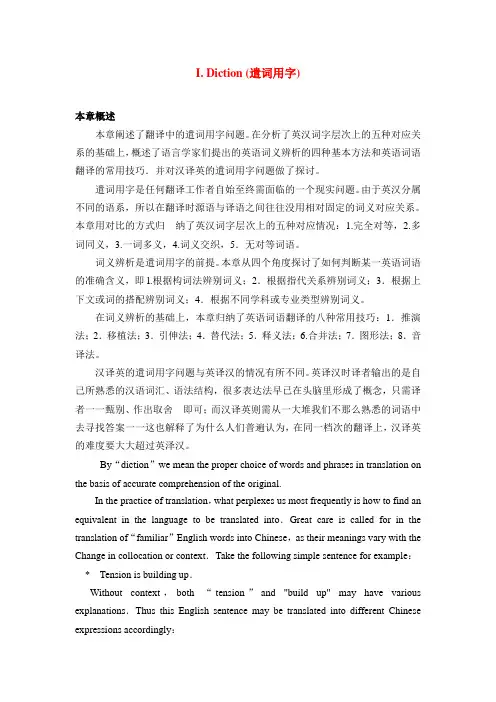
I. Diction (遣词用字)本章概述本章阐述了翻译中的遣词用字问题。
在分析了英汉词字层次上的五种对应关系的基础上,概述了语言学家们提出的英语词义辨析的四种基本方法和英语词语翻译的常用技巧.并对汉译英的遣词用字问题做了探讨。
遣词用字是任何翻译工作者自始至终需面临的一个现实问题。
由于英汉分属不同的语系,所以在翻译时源语与译语之间往往没用相对固定的词义对应关系。
本章用对比的方式归纳了英汉词字层次上的五种对应情况:1.完全对等,2.多词同义,3.一词多义,4.词义交织,5.无对等词语。
词义辨析是遣词用字的前提。
本章从四个角度探讨了如何判断某一英语词语的准确含义,即l.根据构词法辨别词义;2.根据指代关系辨别词义;3.根据上下文或词的搭配辨别词义;4.根据不同学科或专业类型辨别词义。
在词义辨析的基础上,本章归纳了英语词语翻译的八种常用技巧:1.推演法;2.移植法;3.引伸法;4.替代法;5.释义法;6.合并法;7.图形法;8.音译法。
汉译英的遣词用字问题与英译汉的情况有所不同。
英译汉时译者输出的是自己所熟悉的汉语词汇、语法结构,很多表达法早已在头脑里形成了概念,只需译者一一甄别、作出取舍即可;而汉译英则需从一大堆我们不那么熟悉的词语中去寻找答案一一这也解释了为什么人们普遍认为,在同一档次的翻译上,汉译英的难度要大大超过英泽汉。
By“diction”we mean the proper choice of words and phrases in translation on the basis of accurate comprehension of the original.In the practice of translation,what perplexes us most frequently is how to find an equivalent in the language to be translated into.Great care is called for in the translation of“familiar”English words into Chinese,as their meanings vary with the Change in collocation or context.Take the following simple sentence for example:* Tension is building up.Without context,both “tension”and "build up" may have various explanations.Thus this English sentence may be translated into different Chinese expressions accordingly:·形势紧张起来。
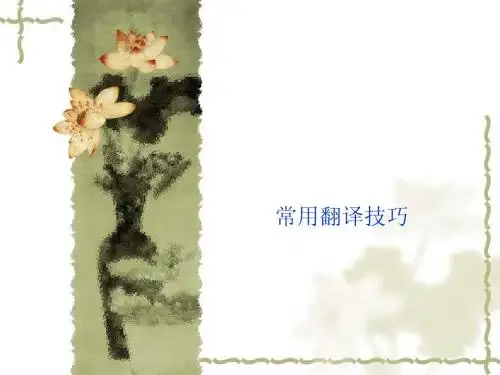
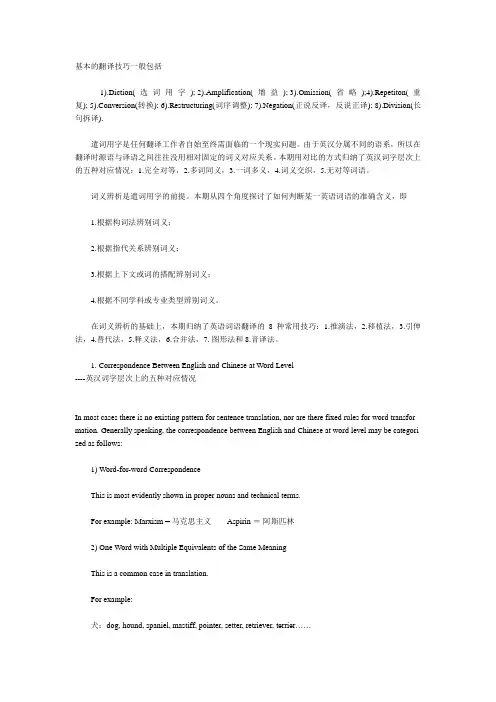
基本的翻译技巧一般包括1).Diction(选词用字); 2).Amplification(增益); 3).Omission(省略);4).Repetiton(重复); 5).Conversion(转换); 6).Restructuring(词序调整); 7).Negation(正说反译,反说正译); 8).Division(长句拆译).遣词用字是任何翻译工作者自始至终需面临的一个现实问题。
由于英汉分属不同的语系,所以在翻译时源语与译语之间往往没用相对固定的词义对应关系。
本期用对比的方式归纳了英汉词字层次上的五种对应情况:1.完全对等,2.多词同义,3.一词多义,4.词义交织,5.无对等词语。
词义辨析是遣词用字的前提。
本期从四个角度探讨了如何判断某一英语词语的准确含义,即1.根据构词法辨别词义;2.根据指代关系辨别词义;3.根据上下文或词的搭配辨别词义;4.根据不同学科或专业类型辨别词义。
在词义辨析的基础上,本期归纳了英语词语翻译的8种常用技巧:1.推演法,2.移植法,3.引伸法,4.替代法,5.释义法,6.合并法,7. 图形法和8.音译法。
1. Correspondence Between English and Chinese at Word Level----英汉词字层次上的五种对应情况In most cases there is no existing pattern for sentence translation, nor are there fixed rules for word transfor mation. Generally speaking, the correspondence between English and Chinese at word level may be categori zed as follows:1) Word-for-word CorrespondenceThis is most evidently shown in proper nouns and technical terms.For example: Marxism = 马克思主义Aspirin =阿斯匹林2) One Word with Multiple Equivalents of the Same MeaningThis is a common case in translation.For example:犬:dog, hound, spaniel, mastiff, pointer, setter, retriever, terrier……3) One Word with Several Equivalents of Different MeaningThis is also very common in translation. For example:carry: 搬、运、送、提、拎、挑、担、抬、背、扛、搂、抱、端、举、夹、捧…..走:walk, saunter, amble, stride, trudge, trapes, shamble, prance, scamper, clump, tiptoe ….羊: sheep, goat, ram, ewe, lamb……4) Equivalents Interwoven with One Another5) Words Without EquivalentsIn this case, an explanation is given instead of an equivalent.For example:clock-watcher: 老是看钟等下班的人阴: (in Chinese thought) the soft inactive female principle or force in the world阳: (in Chinese thought) the strong active male principle or force in the world(目不识)丁: (not know one's) ABC2. Methods to Discriminate the Original Meaning of an English Word-----词义辨析Since English words are prone to various meanings, it is of vital importance for a translator to discern the rig ht meaning of a given word. And the following are the major methods of discriminating word meaning sugge sted by some linguists.1) Judging from the Word FormationIn order to discriminate the original meaning of an English word, it is necessary for us to have a knowledge of English lexicology, and specifically, a knowledge of word formation, such as compounding, derivation, af fixation, blending, acronym, clipping, etc. A good command of them will help to shed light on the correct me aning of some difficult words.For example, the word ""parabiospheric"", which consists of para-(outside) +bio-(biologic) +spheric (havingthe form of a sphere). After a brief analysis, we may safely put it into ""外生物层的"". Another more complicated instance, pneumonoultramicroscopicsilicovolcanoconiosis. This extremely lon g word seems appallingly complicated. However, an anatomic study of its composition enables us to get a cl ear understanding of its meaning: pneumono- (of lung) +ultra- (beyond) + micro (very small) + scopic- (of vi ewing or observing) + silico- (of silicon)+ volcano + coni- ( koni, of dust) + osis (forming the name of a dise ase). Even if we are not sure of the equivalent of this medical term, we may roughly get the right meaning of the long word: a kind of lung disease caused by extremely small silicon particles. And a look into some dicti onary leads us to the definite answer: 硅酸盐沉着病,肺尘病(一种矿工易染的病)。
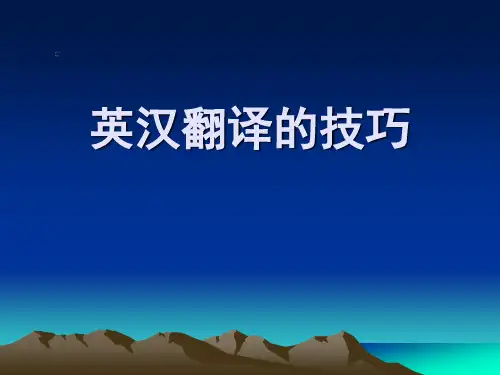
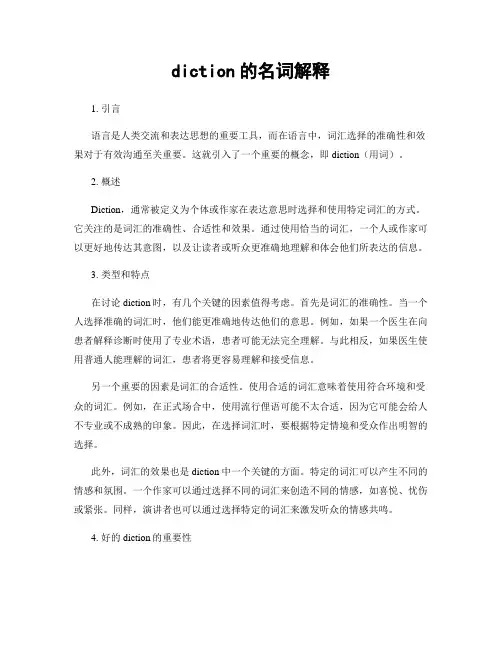
diction的名词解释1. 引言语言是人类交流和表达思想的重要工具,而在语言中,词汇选择的准确性和效果对于有效沟通至关重要。
这就引入了一个重要的概念,即diction(用词)。
2. 概述Diction,通常被定义为个体或作家在表达意思时选择和使用特定词汇的方式。
它关注的是词汇的准确性、合适性和效果。
通过使用恰当的词汇,一个人或作家可以更好地传达其意图,以及让读者或听众更准确地理解和体会他们所表达的信息。
3. 类型和特点在讨论diction时,有几个关键的因素值得考虑。
首先是词汇的准确性。
当一个人选择准确的词汇时,他们能更准确地传达他们的意思。
例如,如果一个医生在向患者解释诊断时使用了专业术语,患者可能无法完全理解。
与此相反,如果医生使用普通人能理解的词汇,患者将更容易理解和接受信息。
另一个重要的因素是词汇的合适性。
使用合适的词汇意味着使用符合环境和受众的词汇。
例如,在正式场合中,使用流行俚语可能不太合适,因为它可能会给人不专业或不成熟的印象。
因此,在选择词汇时,要根据特定情境和受众作出明智的选择。
此外,词汇的效果也是diction中一个关键的方面。
特定的词汇可以产生不同的情感和氛围。
一个作家可以通过选择不同的词汇来创造不同的情感,如喜悦、忧伤或紧张。
同样,演讲者也可以通过选择特定的词汇来激发听众的情感共鸣。
4. 好的diction的重要性一个好的diction是有效沟通的基础。
通过选择准确、合适和有力的词汇,一个人可以确保自己的意思能够准确地被传达和理解。
好的diction还有助于建立信任和引起共鸣。
当读者或听众感到词汇选择符合他们的需求和理解时,他们更有可能被激发兴趣并与作者建立联系。
5. diction的应用领域不同的领域和专业都有自己特定的diction。
例如,在文学和诗歌中,diction非常重要,因为它可以创造出独特的文学风格和情感。
在演讲中,演讲者的词汇选择可以影响他们的口才和演讲的说服力。
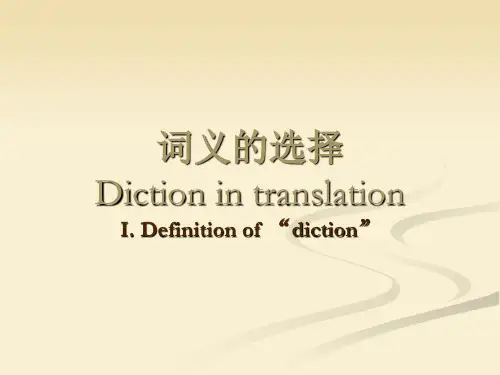
Chapter 1 Lexical Translation(词法翻译)1.1 Diction(选词法)Ⅰ. Choice of Affective Meanings1. In our Second Address on the war, five days after the advent of those men, we told you what they were.【译文】在这伙人上台五天以后,我们在关于前次战争的第二篇宣言中已经向你们说明他们究竟是些什么货色了。
2. Many of the old Orleanist stagers had merged into the Bonapartist lot.【译文】很多奥尔良的老角色也与波拿巴派同流合污了。
3. As a demanding boss, he expected total loyalty and dedication from his employees.【译文】他是个苛刻的老板,要求手下的人对他忠心耿耿,鞠躬尽瘁。
【解析】“demanding”本身属于中性词,但根据句意而翻成贬义词。
4. It is my comfort and my sincere conviction that you are going to try the life for which you are best fitted. I think it freedom and wildness more suited to you than any experiment in a study of office would ever have been, and without that training, you could have followed no other suitable occupation.【译文1】你将体验的生活是最适合你的,这是我的安慰,也是我诚挚的信念。
一.Diction(选词).(一)根据上下文context,抓住准确意思1.老部下a former subordinate2.芹菜长老了The celery is overgrown3.老干部a veteran carder or a carder with great seniority4.菜、肉煮老了overdone underdone5.老百姓common people6.老辈子(长辈)one’s elders7.赌徒把老本输光了lose one’s last stakes8.地主老财money bags9.土匪老巢the bandits’ den10.老成持重experienced and prudent11.老处女spinster12.老粗(没有文化)uneducated person/illiterate13.老大难问题a knotty problem of long standing14.揭某人老底dig up sb’s unsavory past15.老掉牙的书an obsolete book16.你排行老几? Where do you come in your family?17.你算老几? Who the devil do you think you are?18.我算老几! I’m a nobody.19.她办事老练She is experienced and works with a sure hand.20.该换你的老脑筋Get rid of your old way of thinking.21.老气横秋lack youthful vigor21.这是老生常谈It’s commonplace.22.老祖宗forefather, ancestor23.老实点! Behave yourself.24.老主顾regular customer25.老资格old-timer26.老不死a person who has outlived his usefulness27.老糊涂dotard28.老虎钳vice29.老黄牛willing ox; a person who serves the people wholeheartedly.30.你认为我的月薪是500吗?那是老黄历啦。
词汇翻译技巧一、词义的选择(Diction)1. 注意词的搭配汉语和英语两种语言在长期使用过程中形成了各自的固定词组和搭配,所以不能把汉语字词的搭配用法生搬硬套到英语译文中去。
汉、英两种语言的动宾搭配也有不同:例:学文化learn to read and write学知识acquire knowledge学外语study a foreign language学鸟叫imitate birds’ crying同样:发展经济develop our economy开发水资源develop the water resources冲洗胶卷develop a film展开说明develop an idea2. 根据上下文正确理解原文的词义有些汉语说法英译是按字面翻译,具体翻译时应视具体语境而定。
例1:有市场、有效益的速度,才是真正的发展,才是硬道理。
译文:Sound economic growth must be based on strong market demand and good economic returns. This is a .注意:“硬道理”也可根据我们中国文化的“异化”理解,翻译成:.例2:这种情况必须改变译文:This must change.分析:此处要正确理解原文的词义。
汉语措辞中的“情况”一词的基本意义与英语中的circumstance, situation, condition等词相近,但是究竟怎样翻译,还需要根据上下文来决定。
二、词的增补(Amplification)词的增补又常叫增译/增词法,是为使译文准确、通顺、达意。
增译有语义性增译修辞性增译,还有注释性增译(文内阐释或文中夹注)1.增补主语汉语中无主语的句子很多,汉译英时要根据上下文的意思选择适当的代词或名词补做主语。
增加什么主语取决于上下文。
例1:知己知彼,百战不殆译:2. 增补非人称的或强调句中的itit可以指天气、时间,还常用来表示强调、代替不定式等。